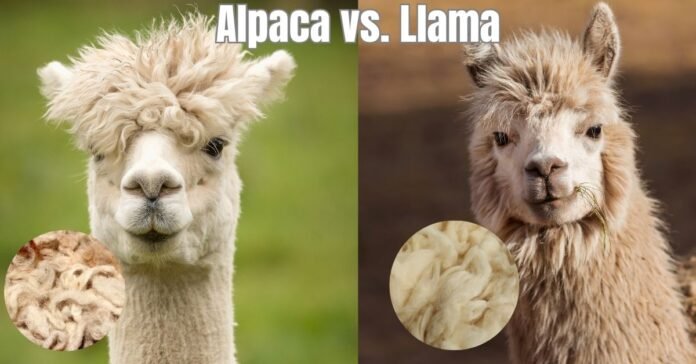Alpacas and llamas are not the same as many people may think they are. They both are in South America, both are long-necked and both are wool producers. The differences are massive, however, between Alpaca vs. Llama Wool.
Individuals tend to research this subject with multiple purposes: someone is a tourist to Peru, someone wants to raise livestock, or someone is a fashion enthusiast who wants to know about luxury fibers. Interestingly, these cute animals have also gained fame around the globe due to memes and social media. However, there is more than the cute faces and there is a world of differences in size, personalities and wool.
Alpaca vs. Llama at a Glance
| Aspect | Alpaca | Llama |
|---|---|---|
| Size & Weight | Smaller (~3 ft tall, 100–175 lbs) | Larger (~5–6 ft tall, 250–450 lbs) |
| Ear Shape | Short, spear-shaped (pointed) | Long, curved “banana” shape |
| Face Shape | Short, blunt muzzle with fluffy fleece | Longer, narrow face with less wool |
| Wool/Fiber | Fine, soft luxury fiber (cashmere-like feel) | Coarse, thick fiber (used for rugs, ropes) |
| Temperament | Shy, gentle, herd-oriented | Confident, independent, often protective |
| Common Uses | Fiber production (yarns, apparel) | Pack animal, guard, sturdy textiles |
Origins & History: A Camelid Heritage
Alpacas
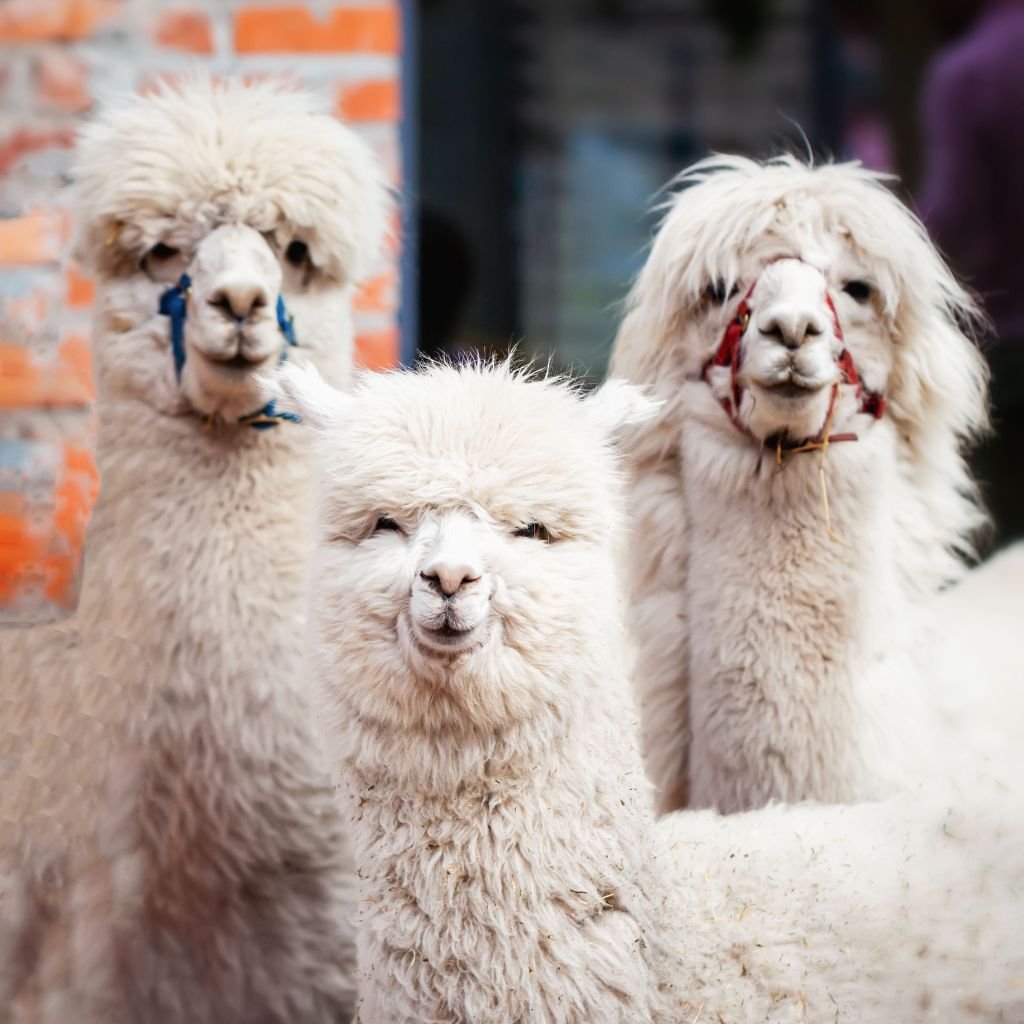
Llamas
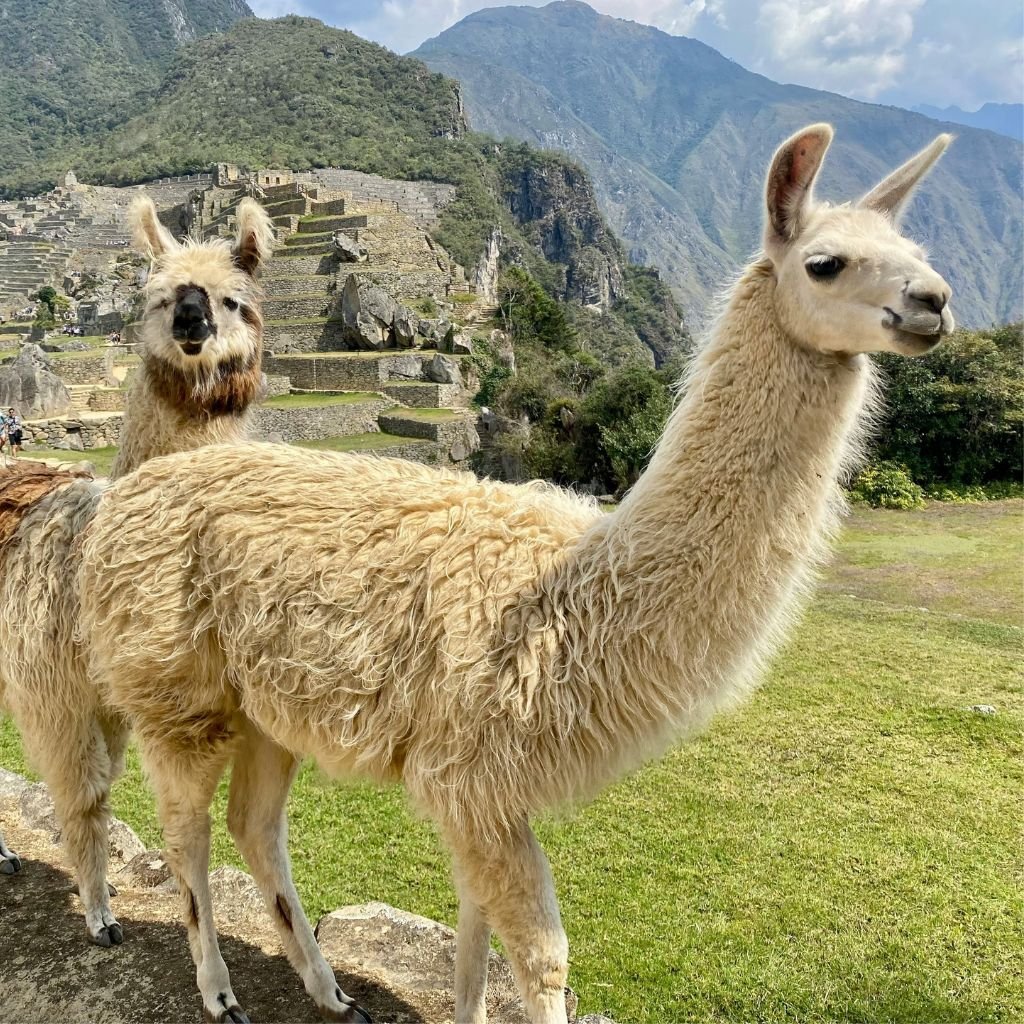
South American Camelids
There are alpacas, llamas, vicunas and guanacos that have a common ancestry of camels. They were brought to South America and they do not have humps like Old World camels do. These Andean species have developed to suit high-altitude habitat and are adapted very well to climate in the mountains.
Andean Ancient Domestication
It has been thousands of years since humans domesticated alpacas and llamas. Alpacas were descendants of wild vicuinas and llamas were descendants of guanacos. Inca farmers used llamas as pack animals, and alpacas as the source of their soft fleece. Throughout the millennium, alpacas and llamas turned out to be central to Andean civilizations, giving us wool, meat and transportation.
Roles in Incan Culture
These camelids played an important role in pre-colonial Andean life. Alpaca wool was an exclusive of royalties and priests. The ships of the Andes were llamas, which transported merchandise through mountainous tracks. They both supplied food (in many cases dried into jerky known as charqui) and hides for clothing. To put it in a nutshell, alpacas and llamas had distinct but equally significant roles in Inca and pre-Inca societies.
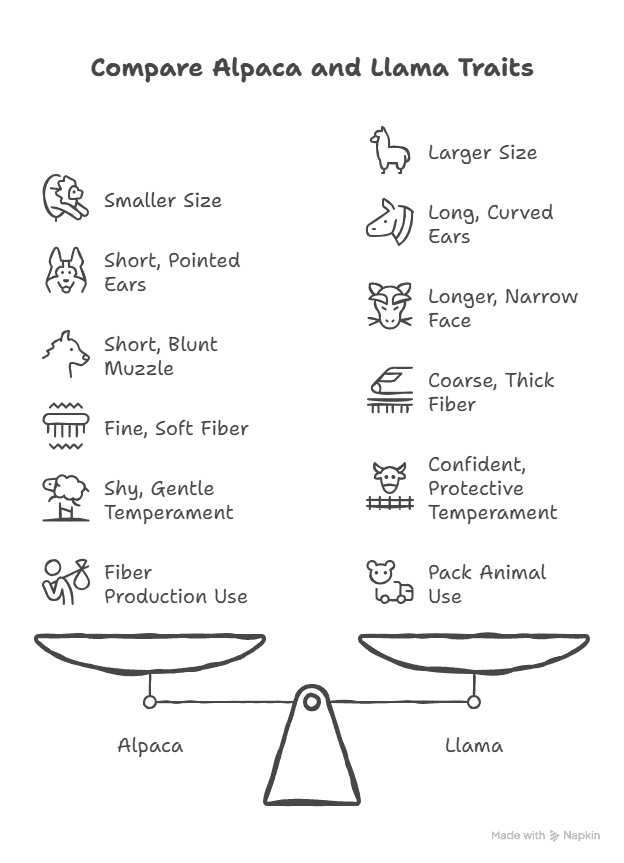
Physical Differences
Size & Weight
Llamas are considerably bigger than alpacas. The shoulder height of an adult llama is approximately 120 cm (47 in) and they may weigh more than 200 kg. On the contrary, alpacas measure about 90 cm (35 in) in height and 55 to 70 kg. This size difference is apparent: when the animal is extremely high and robust, it probably is a llama.
Ear Shape
One easy method of differentiating the two is through their ears. The ears of Alpacas are short and spear-like whereas the ears of llamas are long and curved like the banana shape. In the Llamas, the ears curve inwards creating a special appearance. In reality, the sight of a long curved eared camelid is almost always that of a llama.
Face Shape
The face of an alpaca is a shorter one and wooly. Llamas have lengthier and thinner faces and bigger nose. This implies that alpacas are rounder-looking and fuzzy faced, whilst llamas are thinner and kingly. In short alpacas resemble more of fluffy teddy bears, whereas llamas are more statuesque.
Wool & Fiber Quality: Alpaca vs Llama Wool
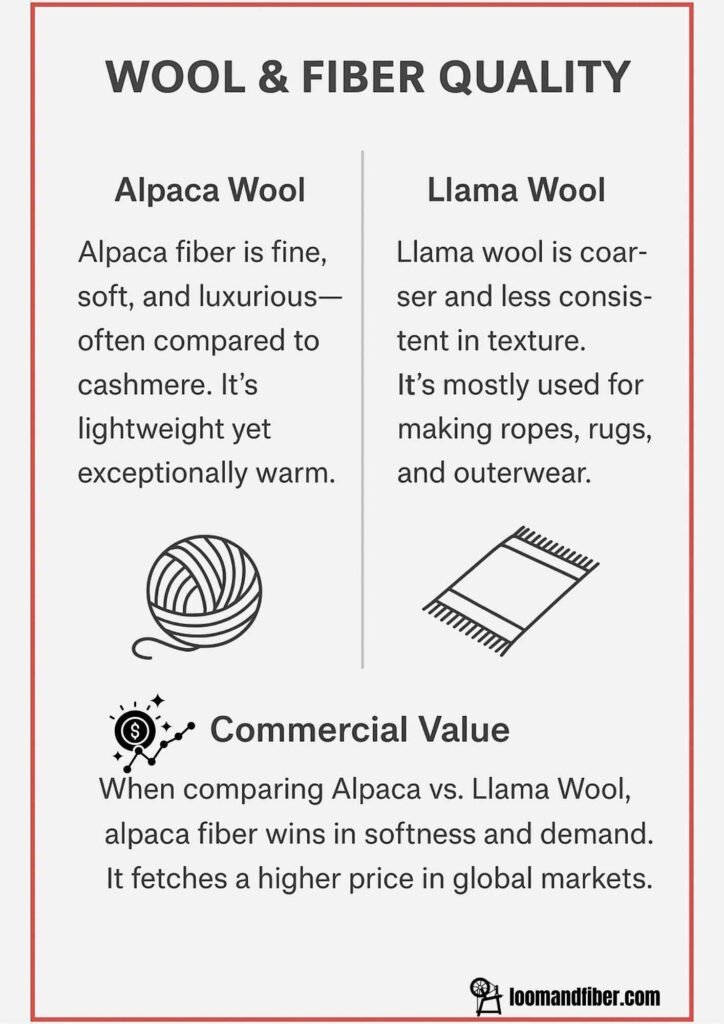
Alpaca Fiber Quality
Alpaca is a high quality soft wool. The fibers are silky, and cashmere. They are also easy to carry, but they hold a lot of heat hence alpaca clothing does not make one feel overly warm. Indeed, many individuals are hypoallergenic to alpaca fleece, which is available in dozens of natural colours. Due to its lightness and coziness alpaca fiber is a luxury ingredient in fashion.
Llama Fiber Quality
The llama wool tends to be coarser. It has a combination of soft under coat and rough guard hairs. What you end up with is a coarser and heavier yarn that does not feel as good on bare skin. But llama is a very strong, warm wool. It is commonly applied in large textiles such as ropes, blankets, and rugs. That is, the llama fiber is tough and insulating, but not as next to skin comfortable as alpaca.
Commercial Value of Fiber
The alpaca fleece has a higher market value. The luxury brands are after it because of its softness and variety of colors. The coarser Llama wool is mostly locally used or used by artisans. Consequently, the alpaca wool is priced at a higher rate. As an illustration, the price of a nice alpaca sweater can be very expensive, far beyond $100, but other similar items made in the llama can be purchased at a fraction of that price. Generally, alpaca farmers make more money selling their fleece than the llama farmers make.
Temperament & Behavior
Alpaca Personality
Alpacas tend to be very docile and timid. They are herd animals and are most comfortable in packs. When alpacas feel threatened they usually run off or produce a low humming noise. They are quiet in their daily life. This docile character causes alpacas to be quite easy to deal with once they get to know you.
Llama Personality
Llamas are more assertive and autonomous. They usually become the defenders of the herd. Actually, llamas are rather aggressive animals, they can run at their enemies or even spit to scare away their enemies or strangers. Due to this courage, llamas make great guard animals. In general Llamas like to be in control as compared to alpacas who like to keep out of trouble.
Spitting Habits
The two species are capable of spitting when angry, although llamas are easier spitters. When annoyed a llama will hock and spit as a warning. Alpacas seldom spit; they spit when they are in a serious argument (which mostly happens inside the herd). Practically this implies that llamas are known to spit regularly but alpacas are far more discreet about it.
Uses & Roles
Alpacas
Fiber Production: The primary source of fine luxury fiber worn in sweaters, scarves and blankets.
Cultural Symbol: It is a symbol of Peruvian textile tradition and sustainable fashion.
Green Livestock: Padded feet and effective grazing conserve soil.
Llamas
Pack Animals: Pack animals are used to transport loads in mountainous areas.
Guard Animals: Keep guard over sheep, goats, and alpacas.
Cultural: Tourist Attraction: Andean parades, festivals, trekking tours are common.
Alpacas vs. Llamas as Pets
Ease of Keeping
Three brown, white and black alpacas standing out of doors.
Alpacas are a smaller size and are usually beginner friendly. All they need is a lawn and a moderate amount of fencing. Llamas are considerably bigger and require heavier fencing and space. But with simple care both are fairly manageable. Either way they require yearly shearing, hoof trimming and routine vaccinations to stay healthy.
Space, Feeding, & Social Needs
The alpacas and llamas are the same: grazing herbivores. They are mostly grass and hay eaters and are allowed mineral supplements. Actually, they have grazing requirements just like sheep or goats- they consume relatively little with reference to their body mass. Neither of the two animals is an loner. Alpacas particularly, require mates of their own sex and llamas like to remain in a small herd.
Friendliness
Most of the alpacas tend to be quieter and more of a herd animal, whilst the llamas tend to be more aggressive and protective. Alpacas are usually more friendly to humans, whereas llamas can be on guard or come to the rescue when they feel there is trouble. Generally, alpacas are more friendly and homely to many owners. Llamas are also affectionate, but by virtue of their size and swagger they should be dealt with by a person who is familiar with lamas.
Economic Value & Farming
Alpaca Wool Industry
Alpaca is an important world commodity. Some countries such as Peru and Bolivia sell the alpaca yarns and garments to different parts of the world. Due to the softness of alpaca wool, it fetches high prices in the fashion industry. Sales of fleece provide many alpaca farmers with the largest part of their income. Simply put, alpaca ranching can be highly lucrative in high wool market prices.
Llamas in Farming
Llamas get involved with a farm primarily by working. They make good pack animals to carry supplies on trails and keep off other livestock predators. Llama meat and wool are utilized in the area, but they do not usually result in significant profits. In many cases, the economic value of a llama is labor-saving: a llama guard can save money on loss to predators.
Profitability Differences
Generally, alpacas can be more profitable per animal because of their quality fleece. A modest flock of alpacas is capable of generating adequate wool to support a business. As an instrument of labor, llamas tend not to produce fiber directly. Accordingly, alpaca farming is regarded as a more productive one in the fiber industry whereas the farming of lama is compensated by utility and by economies of cost.
Cultural and Symbolic Significance
Llamas in Culture & Tourism
Andeans are known to have llamas. They manifest in festivals, folklore and handicrafts. Visitors to Peru, Bolivia and Ecuador will expect to find llamas in historic places such as Machu Picchu. The images of llamas are widely used in textiles and signs within the region. Simply put, llamas represent Andean culture and contribute to the development of tourism there.
Alpacas in Fashion & Export
Alpacas represent luxury fiber. Their wool is sold in the high fashion and eco friendly lines of clothing. Alpaca exports have a huge positive economic impact on Peru: alpaca sweaters, scarves, and yarns are sold all over the world. Consequently, alpacas have been linked to high-end fabrics and eco-friendly clothing.
Internet Popularity
Today the alpacas and the llamas have become internet stars. Llamas frequently feature in memes and viral videos of a comedic nature, with alpacas exalted as being cute and fluffy in look. This animal fame has made people more interested in the both animals. The popularity of alpacas and llamas on the internet today can be seen in the numerous petting zoos and farms that feature those animals as tourist attractions.
Which is Right for You? (Farmer’s & Buyer’s Guide)
If You Want Fiber (Yarn and Clothing)
In case you are going to give more preference to soft and high quality fiber, alpacas are the more suitable. They also make luxurious fines, which are suited to sweaters and scarves, among other clothing. Llama is darker and heavier. Practically speaking, alpacas are the best in the way of making warm next-to-skin clothing.
Should You Want a Pack or Guard Animal
Llamas are better in the event you require a working animal. Llamas are capable of heavy-carrying (up to approximately 45-60 kg) and guard or protect on behalf of a herd. Alpacas are not large enough to make serious pack. Therefore, with trekking, hiking, or herding livestock, llamas are the viable choice.
If You Want a Pet
With a pet of exotic nature, think of temperament and size. Alpacas are more resilient and could be the choice of beginners or a family; being small and usually very docile. Llamas are bigger and protective; they are affectionate, but they need an owner who can manage their power. After all, an alpaca could be a great fit, should you be seeking a peaceful, furry pet. You may prefer a more protective animal, like a llama, in case you want a bold animal to secure your property.
Conclusion-
Comparing Alpaca vs. Llama Wool, alpacas have an obvious advantage in terms of softness, warmness, and commercial worth. Their fineness fiber is also used in luxury textiles and therefore are popular in the fashion industries.
Instead, Llamas are strong and pragmatic. They are good watchdogs and pack animals, vital to rural life and tourism.
In case you need production of fiber and light temper, make up your mind on alpacas. However, Llamas are your best bet when you need a robust, all-purpose and protective friend. In any case, both beasts represent the beauty and cultural wealth of Andes- a symbol of the balance of power and meekness of nature.
FAQs
Yes, in the senses of softness and fineness. The alpaca wool is finer and softer, which makes it ideal in next-to-skin clothes. Llama wool is stiffer and heavier and should be used as blanket or carpet. Alpaca fiber is typically superior to luxurious, soft garments.
Yes. The alpaca fibers are air trapped hollow and offer excellent insulation. Even a lighter alpaca sweater would be warmer than a heavier llama. Llama wool is warm as well, although the fine structure of alpaca can sometimes be more warm-to-weight.
